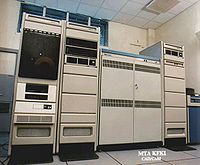TPA-11/580
From Computer History Wiki
From hampage.hu:
- The TPA-11/580 is the fastest and high-performance 32-bit, open architecture member of the KFKI TPA-family. With a microcoded central processing unit, the speed and performance is due to its efficient instruction set and the paralell execution of independent procedures. Its operating system is the VAX/VMS virtual memory management system that can use up to 4 GBs of memory and can work with intrinsically infinite program lengths" (KFKI TPA-11/580 Hardware Handbook)
- After producing PDP-11 clones, KFKI decided to build a "clone" of the Digital VAX-11/780. There was great demand on computers of this size and performance, but due to the restrictions of the "western countries", no real VAX was allowed to be shipped to Hungary or to any other country of the "eastern bloc". The VAX had an appeal with its PDP-11 compatibility mode, and it was microcoded, so the main goal was to construct an "iron" that runs the original microcode.
- The project started in 1983, and ended in 1987. Cloning the VAX-11/780 was hard, because the development team didn't have a machine to examine, they used what they could get access to, so the process took rather long time.
- The main specifications of the TPA-11/580:
- Microcoded 32-bit CPU:
- 244 native instruction + PDP-11 instructions for compatibility mode
- 16 x 32-bit general purpose register
- 4 CPU operating modes:
- kernel, executive, supervisor, user
- 3 2-bit, high-speed, asynchronous system bus:
- SBI (Synchronous Backplane Interconnect)
- Devices are connected to the SBI via so-called NEXI (plural for NEXUS). There are three kinds of devices on the bus:
- The CPU
- The memory
- Adapters of other busses like UNIBUS (UBA), MASSBUS (MBA)
- The CPU had a cycle time of 200 ns. It was constructed from SSI and MSI ICs (TTL Schottky and ECL). The processor consists of 26 (or 29 depending on options) cards with Intel, AMD, TI and other discrete components. There's no such thing as card-for-card compatibility with the VAX-11/780, so you cannot exchange cards between the TPA CPU and the VAX CPU, but the whole unit operates and looks like from the software's view as if it were an original DEC machine. It run VAX/VMS, the original diagnostics and all software developed for VAX/VMS.
- The memory subsystem consists of the memory controller (connected to the SBI) and the storage modules (connected to the controller). The TPA-11/580 could handle two memory controllers, so the maximal memory amount with the MS580-C controller was 2x4=8 MB. There was another controller, the MS580-F that was to be able to use 64 MB, but I don't know if that was ever manufactured. The subsystems stores everything in 64-bit quadwords with 8 bit of ECC (Error Correcting Code) information attached to each quadword (which gives 72 bits total).
- The UBA (Unibus Adapter) connects the main system bus to the asynchronous UNIBUS. The adapter has its own arbitration and it also translates the 30-bit SBI addresses to 18-bit UNIBUS addresses, handles DMA and data buffering (The UBA does 4 UNIBUS-cycles on one SBI cycle).
- The console system was a qbus machine called TPA-11/110 or TPA-Janus. It was based on the russian MicroPDP-11 compatible Elektronika MC1201.01 card, and contained a 5.25" mini-floppy unit, an EPROM that emulated another floppy and an RX01-compatible floppy disk formatter. This subsystem was able to do everything that an LSI-11-based VAX-console could do, including running diagnostics, doing ODT or bootstrapping the TPA-11/580.
- More than 20 TPA-11/580s were sold.
External links
| v • d • e VAX Computers and Operating Systems |
|---|
| VAX-11/7xx (including VAX 86x0) - VAX-11/780 • VAX-11/785 • VAX-11/750 • VAX-11/730 • VAX-11/725 • VAX 8600 • VAX 8650
VAX 8000 series (excluding VAX 86x0, above) - VAX 82xx/83xx series • VAX 85xx/87xx/88xx series MicroVAXen (many types also come in VAXserver and VAXstation models) - MicroVAX I • MicroVAX II VAXstation Series - VAXstation I • VAXstation II Late Model VAXen - VAX 4000 series • VAX 6000 series • VAX 7000 series • VAX 9000 series • VAX 10000 series |
| Special Purpose VAXen - VAXft series • rtVAX series • Infoserver series
Clones - CM 1700 • TPA-11/580 |
